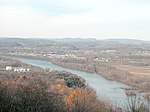Kapp Heights, Pennsylvania
Census-designated places in Northumberland County, PennsylvaniaCensus-designated places in PennsylvaniaUse mdy dates from July 2023
Kapp Heights is a census-designated place located in Point Township, Northumberland County in the state of Pennsylvania. The community is located very close to the borough of Northumberland along Pennsylvania Route 147, near the confluence of the West Branch Susquehanna River and Susquehanna Rivers. As of the 2010 census the population was 863 residents.
Excerpt from the Wikipedia article Kapp Heights, Pennsylvania (License: CC BY-SA 3.0, Authors).Kapp Heights, Pennsylvania
14th Street, Point Township
Geographical coordinates (GPS) Address Nearby Places Show on map
Geographical coordinates (GPS)
| Latitude | Longitude |
|---|---|
| N 40.899444444444 ° | E -76.81 ° |
Address
14th Street 346
17857 Point Township
Pennsylvania, United States
Open on Google Maps








